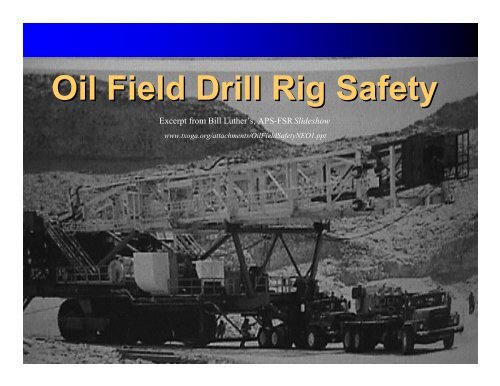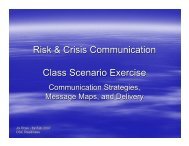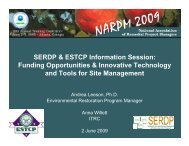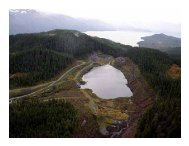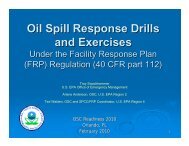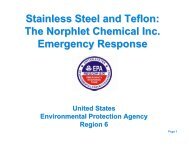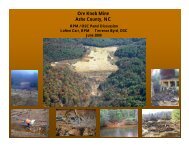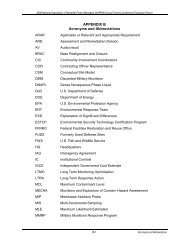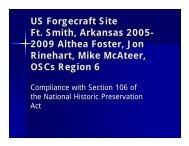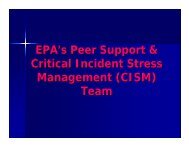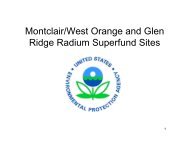1 Oil Field Drill Rig Safety
1 Oil Field Drill Rig Safety
1 Oil Field Drill Rig Safety
You also want an ePaper? Increase the reach of your titles
YUMPU automatically turns print PDFs into web optimized ePapers that Google loves.
<strong>Oil</strong> <strong>Field</strong> <strong>Drill</strong> <strong>Rig</strong> <strong>Safety</strong>Excerpt from Bill Luther’s, APS-FSR Slideshowwww.txoga.org/attachments/<strong>Oil</strong><strong>Field</strong><strong>Safety</strong>NEO1.ppt1
Unsafe ActorUnsafe Condition2
REMEMBER………………………..No job is so important and Noservice is so urgent – that wecannot take time to perform ourwork safely.3
This orientation is tohelp acquaint thosepersonnel withoilfield safety rules,regulations and/orprocedures.This orientation is NOTcertification.4
More than 90 % of all accidents are avoidable, being causedby human error rather than by mechanical failure.It is extremely important that every person on a drilling rigdevelop a sense of safety in drilling operations.That person must use this sense in combination with the kind ofgood judgment it takes to drive a car safely, or to do anythingelse in a safe manner.5
Vocabulary – cont’d• Competent Person – One who is capableof identifying existing and predictablehazards in the surround or workingconditions which are unsanitary, hazardous,or dangerous to employers and who hasauthorization to take prompt correctivemeasures to eliminate them, or who canrecommend directly to persons in authoritythat such corrective measures be taken.7
Vocabulary – cont’d• Guarded – Covered, shielded, fenced, enclosed, orotherwise protected by means of suitable covers,or casings, barrier rails, safety bars, or screens toeliminate the possibility of accidental contact with,or dangerous approach by persons or objects.• Hazard – Any occupational condition orcircumstance which is likely to cause death, injuryor illness.8
Vocabulary – cont’d• Hazardous Substance – one by reason of beingexplosive, flammable, poisonous, corrosive,oxidizing, irritating, or otherwise harmful, is likelyto cause occupational death, injury or illness.• Qualified–one who by possession of a recognizedegree certificate, or professional standing, or whoby extensive knowledge, training and experiencehas successfully demonstrated ability to solve orresolve problems relating to the subject matter, thework, or the project.9
Vocabulary – cont’d• Should – means recommended.• Suitable – that which fits, and has thequalities or qualifications to meet a givenpurpose, occasion, condition, function orcircumstance.• Supervisor – person who has been givencontrol, direction and/or supervision ofwork provided by one or more employees.10
Vocabulary – cont’d• Variance – an exception to a promulgatedstandard, rule or regulation granted by theDepartment of Labor, or appropriate agency.• Well Servicing – any action or work other than theoriginal drilling of the well, related, but notlimited to the completion, re-completion, downhold maintenance, or termination of the well.11
<strong>Oil</strong> Company/Operator – Has control of the casing and themud program being followed drilling the well.<strong>Drill</strong>ing Contractor – Head of drilling operation. Determinesthe overall safety practices/policies and the manner in which asafety program is carried out by the various supervisors.<strong>Drill</strong>ing Superintendent – Represents top management of thedrilling contractor. Supervises the operations of several rigs inthe area.Tool pusher – Directly responsible to the drilling superintendentfor carrying out work assigned to the rig. Supervise allpersonnel, ensures machinery is in a safe operating condition.Investigates each accident or injury to determine its cause.12
<strong>Drill</strong>er – Works directly under the tool pusher. Responsible forwork of the crew and operation of the rig. The driller sets the pumpspeed and pressure, operates the draw works and rotary andmanipulates the controls to operate the rotary and drill stem to makehole.Crew Members – Must work for safety as a team! Must knowhis/her job and stay constantly alert to what is going on. Use PPE.Use proper tools. Learn to foresee and prevent accidents. Use stairsand ladders as intended.13
A Sampling of OSHAViolations & Standards Cited1. Employee riding the traveling blocks – 5(a)(1)2. No geronimo line from monkey board – 5 (a)(1)3. Floor holes in rig floor/crown walk around-1910.23(a)4. <strong>Safety</strong> goggles not clean and in good repair-1910.1335. Break Out Tongs – wire clips had U-bolt on live end of line. 5(a)(1)6. Kelly hose not secured with chains 5(a)(1)7. V-Door opening not guarded-1910.2314
UNIQUE HAZARDS TO THEOIL AND GAS INDUSTRYPoor Machine GuardingCatheadsRotary TablesGasesFallsSlippingHigh Pressure HosesTripping15
New Mexico based landdrilling rig.If you are the derrick manand weather like this isapproaching, what do youdo?16
Cathead = Pinch Point17
TONGS – SPINNING CHAINCut off fingers, thumbsSmashed fingers, hands etcTEAM WORK !!Be a Team,Work TogetherWatch out for each other18
Can you find the hazard(s)?423119
Look Familiar ??20
What problems doyou see with thesepictures ?21
What is really theHAZARD ????22
Rotary Guard23
IT’S THE LAW !In the State of Texas, all persons working in the oil field whereH2S concentrations are known MUST complete a H2Scertification course annually.The objective is to educate employees about the physical &chemical properties, toxicity, concentration levels, personalprotective equipment use, detection measures, rescue and firstaid.The best way way to reduce the chance of employee exposure toH2S is to provided the best possible training, provide appropriatepersonal protective equipment, and ensure employs follow thecorrect work procedures, rules and requirements.24
COMMON SOURCES OFNaturally in natureH2S<strong>Oil</strong> <strong>Field</strong>s – Mines – Volcanoes –Geothermal ExplorationThrough decay of organic matterFishing industry – Tanneries - Manure ProcessingMunicipal sewers - Brewery Industry – LandfillsChemical ProcessesBy Product – Catalyst – Felt Making – Asphalt Roofing25
H2S or Toxic Gas ExposureHydrogen Sulfide – characterized by an odorof rotten eggs. A very small concentrationcan be fatal. When encountered, employees must wearapproved type masks when their work requires them to beexposed to the gas,in any way.26
H2S or Toxic Gas ExposureHydrogen Sulfide is highly toxic, colorless, and heavierthan air. It has the odor of rotten eggs, initially.Most frequently encountered in the production and refining of high sulfurpetroleum and in natural gas. It burns with a blue flame and produces SulfurDioxide.It forms an explosive mixture with air. The LFL is 4.3%and the UFL is 45.5%.27
H2S or Toxic Gas ExposureIts odor is NOT a reliable warning signal becausehigher concentrations of the gas temporarilydestroys the sense of smell. This is the primaryreason for employees not detecting the presenceof H2S and consequently inhaling a lethalamount. The only positive means is by testingwith an approved H2S detector. DO NOT RELYSOLELY ON THE SENSE OF SMELL!28
What is he standing on?Why?Is he tied off?What do you think wouldhappen if he falls??29
Racking Pipe – Strains-Sprains, Caught Between etc….30
Ready to set the slips.Note: 3-people/3-handlesAlways set and removewith three (3) people toavoid back strain.31
Stabbing a joint, prior tomake-up. Note spinningchain, position of arm andhand ??32
This happens on adaily basis.33
Summary• <strong>Oil</strong>field <strong>Safety</strong> is no different than <strong>Safety</strong>anywhere else. Different tools, differentequipment, but the same COMMOM SENSEprinciples.• Look for Hazards, protect you and your co-worker. Remember,Identifythe Hazard,Develop a plan to fix it and then Fix it!Fix Your Hazards = No Accidents• Get everyone interested. Its for you good andtheirs.34


